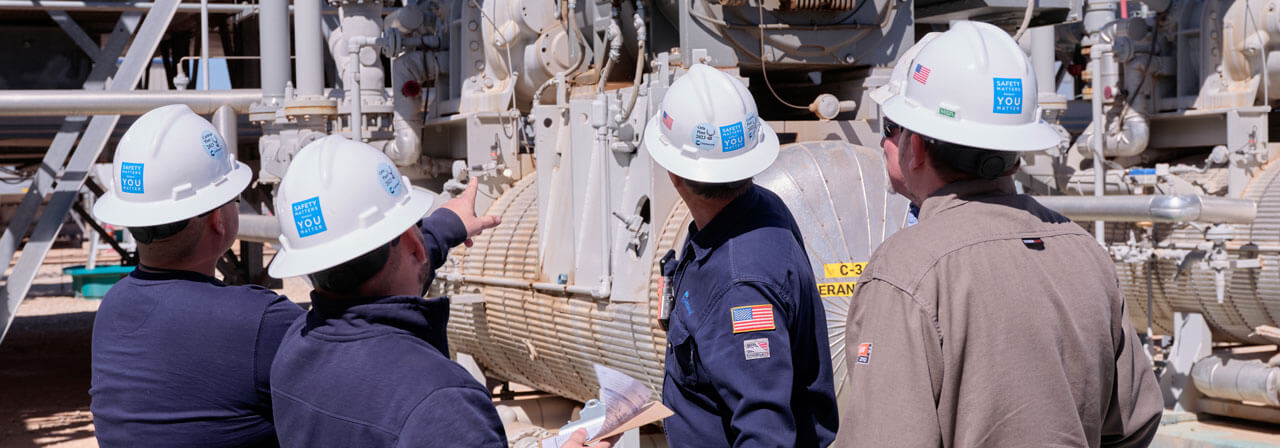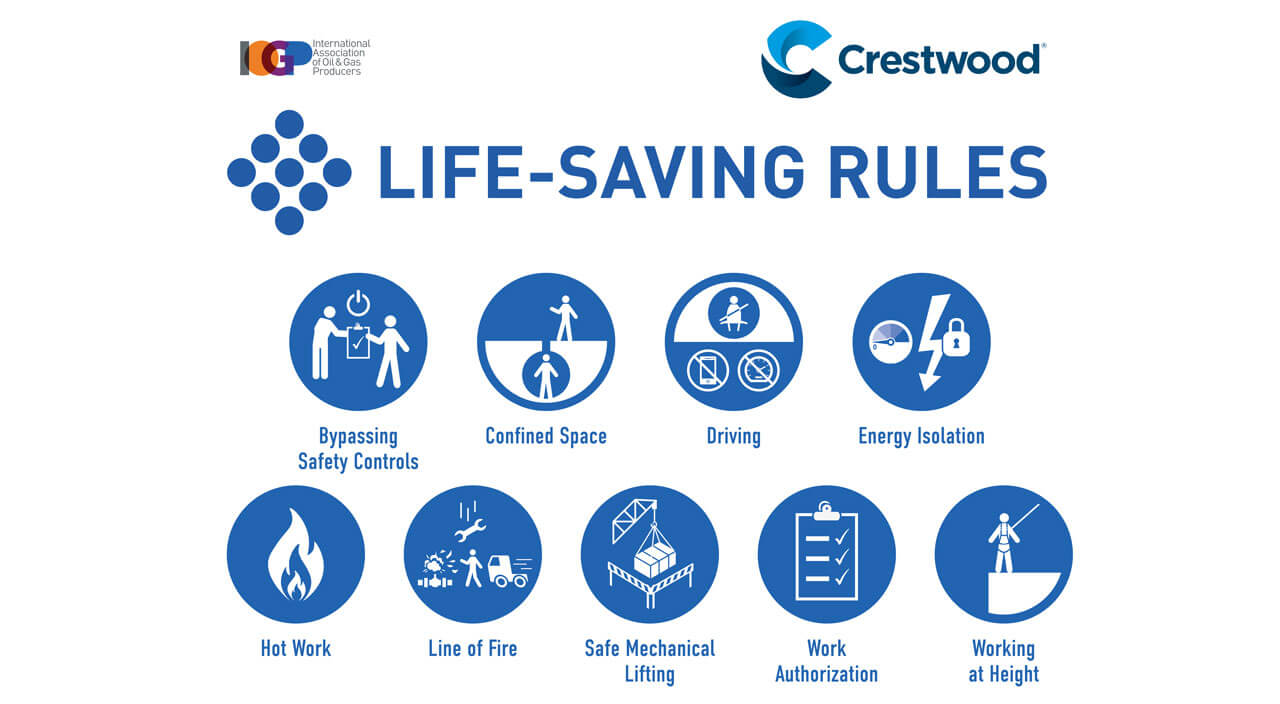Prioritizing Safety
Our objective is for everyone to return home safely at the end of each day. We have a steadfast dedication to safety that permeates every aspect of our business. We believe that safety is a shared obligation and that everyone has a responsibility to promote safe work practices and identify opportunities for continuous improvement.

Approach
To maintain our ongoing emphasis on safety and the behaviors we expect from our employees, we focus on continual awareness and engagement, and seek to positively influence decision-making that promotes safe outcomes through the prevention of incidents or injuries. Our Health, Safety and Environmental (HSE) Policy guides our comprehensive approach to safety and applies to all Crestwood operations.
We establish risk-based engineering and process controls to manage the existing and potential hazards in our work environment. We promote understanding and conformance with safety expectations and standards through core training, lessons learned and safety standdowns. We also empower our employees to use Stop Work Authority to reassess hazards if it appears a job cannot be completed safely. We recognize and reward employees whose self-initiated actions and behaviors demonstrate a high-level of commitment to the safety and welfare of Crestwood employees and local communities.
Our Journey and Progress
We recognize that a strong safety culture is established through a demonstrated commitment to safety at all levels of our organization, from executives to supervisors and employees. This commitment is evident in our organizational strategy, individual involvement and the actions and words of all our team members.
| Focus Area | Key Achievements |
|---|---|
| Integrated Sendero Midstream and Oasis Midstream Employees into Safety Culture |
|
| High-Risk Standards and Health and Safety Handbook |
|
| Facility Emergency Response and Action Plans |
|
| Industrial Hygiene Program |
|
| Corporate Safety Program |
|
| Safety Training Platform |
|
| Data Integration and Reporting Capabilities |
|
Crestwood Adopts Life-Saving Rules
In early 2023, we adopted the Life-Saving Rules, which were developed by the International Association of Oil and Gas Producers (IOGP) and are recognized as an industry best practice to prevent workplace fatalities. The Life-Saving Rules are meant to draw attention to the activities most likely to lead to a fatality, and the life-saving actions over which an individual has control.
The Life-Saving Rules have been incorporated into our Health and Safety Standards and existing hazard recognition process. Applying the Life-Saving Rules during daily work tasks at Crestwood will:
- Enhance personal accountability in task planning by requiring one final check to ensure all rules can be followed before work starts
- Enable increased transfer of knowledge, experience and lessons learned between personnel
- Improve clarity of expectations and promote consistent usage by our employees and contractors
The Life-Saving Rules are an important tool for our employees and our contractors as we continue to enhance our worker safety program.

Safety in Action Program
We continued to advance our Safety in Action program in 2022, specifically focusing on developing opportunities for employees to participate on regional safety committees to share best practices and lessons learned, enhancing our employee engagement efforts through a continuation of our safety spot awards, implementing a National Safety Month campaign focused on varying safety topics each week and celebrating safety milestones and achievements in our monthly field safety meetings.
While we know our safety culture is dependent on the actions of all our employees, there were several individuals that stood out in 2022 whose self-initiated actions demonstrated a high-level of commitment to the safety of our workforce and the communities in which they work. Since we started the safety spot award program in 2021, we have provided over 55 awards with representation from each of our core asset locations.
Spot Award Winners: Williston Basin
- Identified and implemented an alternative method for tightening bolts to eliminate pinch-point hazard
- Voluntarily provided positive on-the-job training and mentorship for less experienced peers
- Promoted safe work practices during routine tasks
- Worked with a contractor who was planning to conduct a high-risk task to ensure procedures, training and a mitigation plan was in place prior to starting the job
A special thanks to Darry Steichen, Matt Jensen and Brett Banie for their continued commitment to safety.
Key Performance Indicators
Overall, we had a strong 2022 safety performance, maintaining our total recordable incident rate and improving our days away, restricted or transferred incident rate. However, our preventable vehicle incident rate and lost time incident rate increased, largely due to incidents at newly acquired assets within the first few months of ownership. Immediate changes were implemented by our operations leadership team and employees were trained in the Smith System Driver Training Program, resulting in no additional similar incidents.
Safety Metrics: Employees
Total Recordable Incident Rate (TRIR)
| Rate | 2020 | 2021 | 2022 |
| TRIR | 0.94 | 1.06 | 1.06 |
Key Employee Safety Stats
Safety Metrics: Contractors
Total Recordable Incident Rate (TRIR)
| 2020 | 2021 | 2022 | |
| TRIR | 2.91 | 0.00 | 1.20 |
Key Contractor Safety Stats
Reaching Triple Zero
We track incidents annually by regional asset group to drive performance and achieve zero Occupational Safety and Health Administration recordable injuries, zero lost time injuries and zero preventable vehicle incidents (Triple Zero). At the end of the year, each asset is scored on their progress. In 2022, we had six regional groups achieve Triple Zero. Additionally, our Tres Palacios Gas Storage Facility and LPG Terminals – Rosehill, Seymour and Bath - surpassed eight and seven years, respectively, without an incident.
Contractor Management
We strive to work closely with our contractors to guarantee a shared dedication to safety. In 2022, after spending several years enhancing our contractor management program, we formalized the standards and performance requirements and aligned them with the Life-Saving Rules. We plan to roll out the revised program in 2023.
We utilize ISNetworld to track and manage performance and adherence to our safety standards. We hold contractors accountable for complying with applicable laws, regulations and industry standards. If a contractor fails to meet our minimum requirements, they must submit a risk management plan for review and approval and expect to implement specific improvements and additional risk mitigation measures before completing work for or on behalf of Crestwood.
Business Continuity, Crisis Management and Emergency Response
As we work to mitigate safety-related risks across our operations, we also prepare for potential events, planned or unplanned, and recognize that effective emergency response requires comprehensive and regular training.
In 2022, our response teams completed over 800 hours of face-to-face and virtual crisis and emergency response drills.
We collaborate and coordinate with local emergency management agencies, including fire rescue teams and health care providers, to discuss plans, explore potential synergies, provide a comprehensive understanding of our operations and the type of response that might be needed in an emergency and conduct drills. We maintain and monitor a 24/7 emergency hotline accessible to internal and external stakeholders, allowing for a swift and effective response.
In 2022, we enhanced our business continuity framework to enable a coordinated transition from response to recovery and restoration of normal business operations for critical systems. Our efforts focused on strengthening recovery and restoration actions for operations and financial systems, as well as enhancing emergency and cyber response measures.
Looking Ahead
Safety is our top priority, and it is critical to our long-term business success. To continue upholding our commitment to safety, in 2023, we intend to:
- Maintain our focus on achieving Triple Zero incidents
- Continue to integrate the Life-Saving Rules into our hazard preparedness efforts for daily work tasks and support consistent application of high-risk task standards and forms
- Focus on identifying opportunities for increased employee participation in health-and safety-related practices
- Conduct our third-party employee safety perception survey facilitated by the National Safety Council to drive future work plans
- Continue to focus on further integrating our safety culture at the corporate level through regular safety meetings
- Continue to enhance our data collection, integration and reporting capabilities to drive performance improvements
- Refine, document and test recovery and restoration procedures as part of our business continuity program
- Continue to enhance our annual crisis drill to ensure continuous improvement including the incorporation of innovative best practices